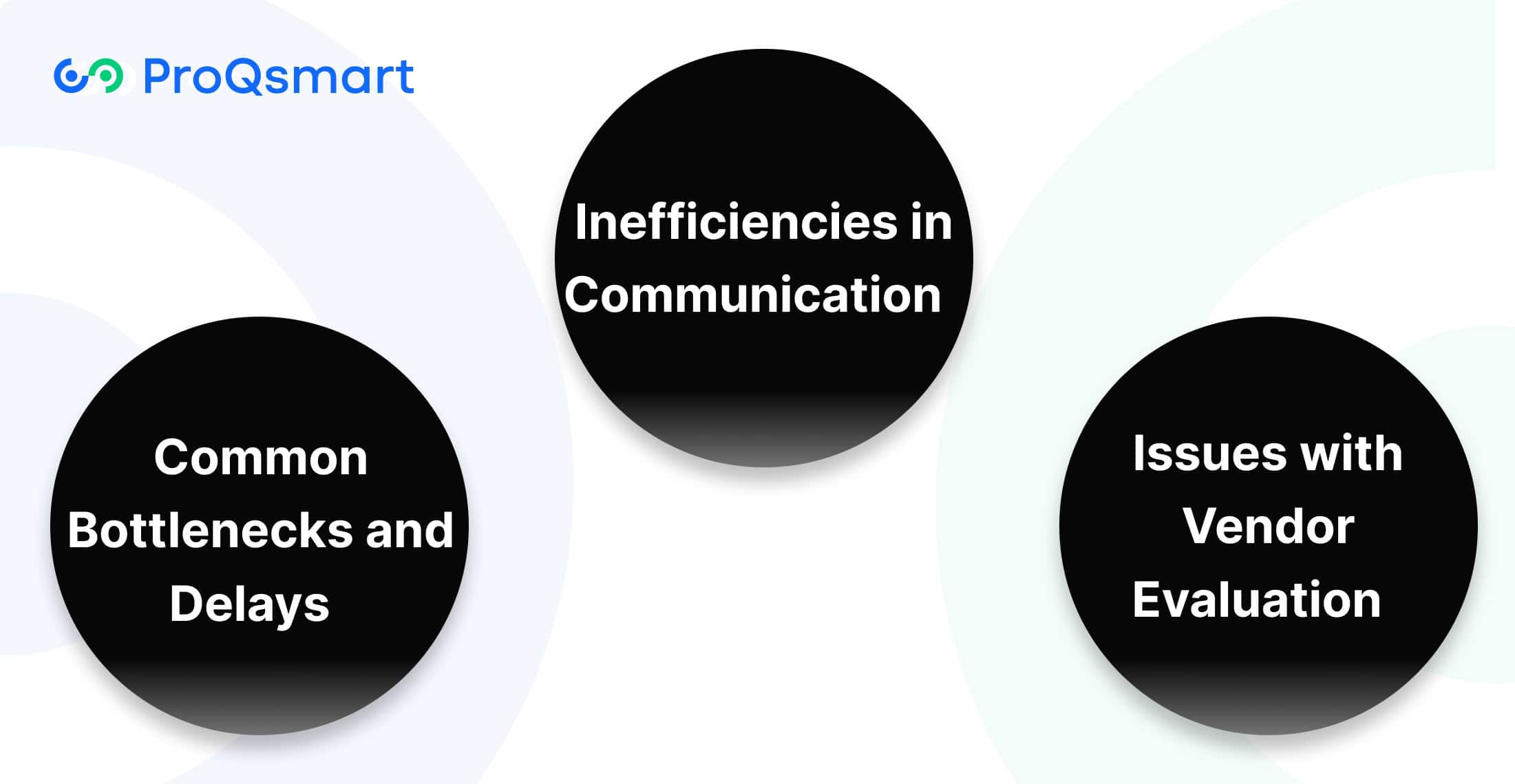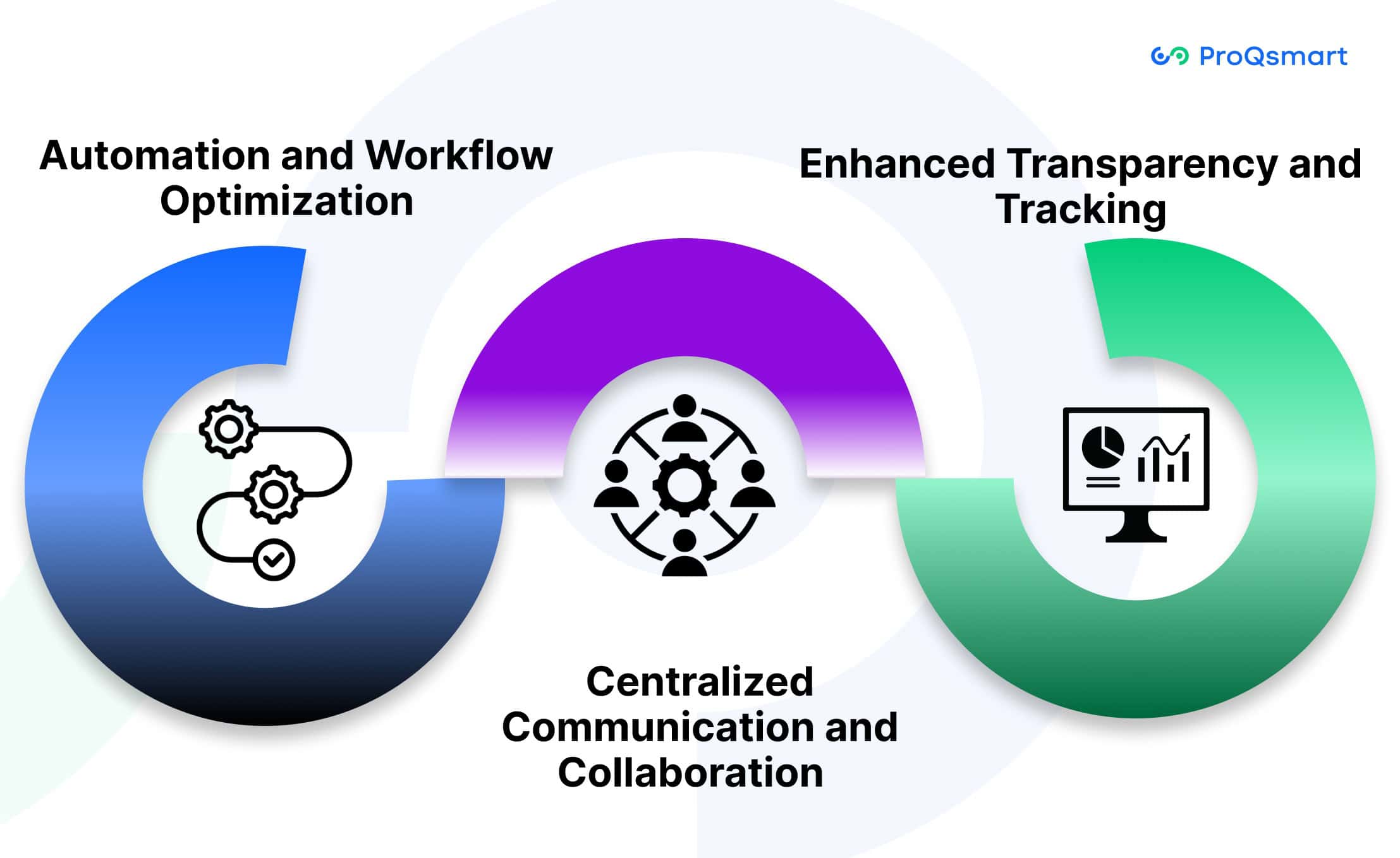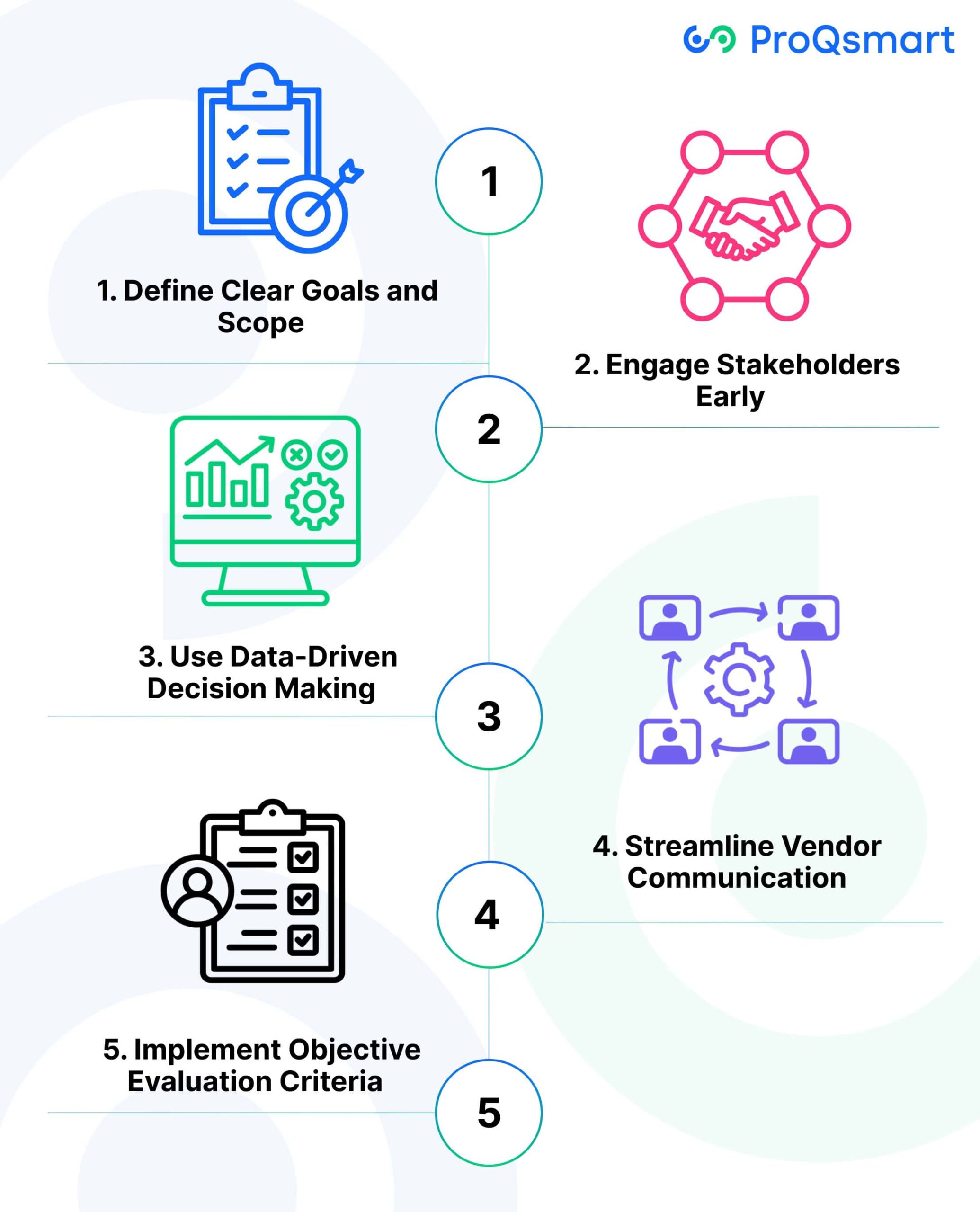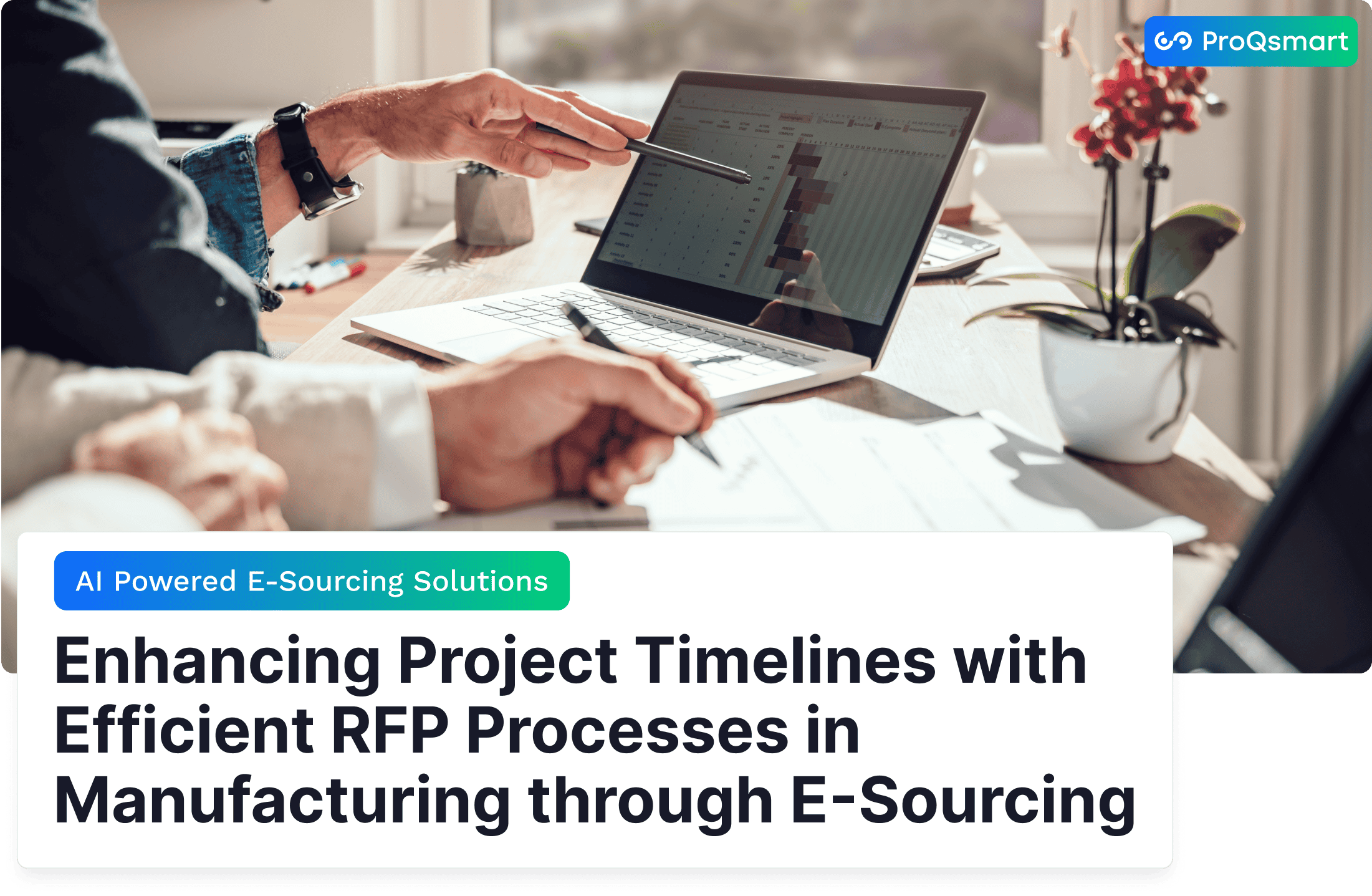An RFP, or Request for Proposal, is a standard business practice. They publish it to solicit competitive proposals from qualified vendors or contractors. It also details project requirements, evaluation criteria, and submission guidelines, assisting organizations in identifying the most qualified partner for their unique needs.
RFPs are common across sectors, including construction, hospitality, and manufacturing, to promote transparency and competitive pricing. Developing a detailed RFP helps you get better responses from suppliers and makes your decision process quicker and easier.
It mitigates risks by aligning all parties with the scope and expectations of the project. To procurement professionals, an RFP process is key to establishing effective supplier relationships and getting the best results possible.
With the knowledge of RFPs, businesses can avoid pitfalls and make strategic decisions that best serve their long-term interests and day-to-day operations. This article will explore how leveraging e-sourcing tools to create effective RFPs can significantly enhance project timelines in manufacturing, ensuring that projects are completed on time and within budget.
Understanding the Importance of RFP in Manufacturing
The RFP process is a foundation in procurement, and can have a huge impact on the manufacturing industry. It allows organizations to better understand the complex and challenging sourcing of materials, services, and technologies, to the benefit of strategic goal alignment.
Manufacturers can save valuable time and resources during the procurement process by creating and managing effective RFPs. This strategy improves operational efficiency and keeps them competitive in a challenging market.
Role of RFP in Procurement
RFPs play a crucial role in vendor selection and contract negotiation by providing a structured framework to evaluate proposals. They enable procurement teams to compare vendors not only on cost but on quality, delivery timelines, and compliance with organizational standards.
For instance, a weighted scoring system, where cost might account for 30% of the decision, ensures balanced decision-making. Aligning RFPs with business goals further strengthens procurement strategies.
For example, when sourcing a new material, RFPs allow teams to define requirements collaboratively, ensuring clarity and minimizing delays. Using platforms like ProQsmart, which automates workflows and tracks supplier performance, can further enhance procurement efficiency by reducing manual errors and improving transparency.
Impact on Project Timelines
When done well, clear, specific, and comprehensive RFPs can lead to drastically improved project timelines. A well-structured RFP minimizes uncertainty, allowing vendors to submit competitive proposals.
This transparency eliminates much of the volleying during negotiation phase, which usually stretches timelines. For example, when specifications are clear from the start, manufacturers dodge potentially weeks of lost time due to miscommunication about expectations.
According to public & private sector case studies, firms that leverage RFP management tools, such as ProQsmart’s e-tender module, complete their projects quicker. These improvements come from better integration, more reflection, and more streamlined processes.
Contribution to Operational Efficiency
RFPs promote operational efficiency by streamlining workflows and eliminating procurement bottlenecks. Sourcing a new machine can be a lengthy process.
With an RFP, you set expectations in stone from the start, avoiding any confusion from the get-go. With the help of RFP management solutions, such as ProQsmart, manufacturers can centralize these activities, from the pre-qualification through the supplier performance monitoring.
This not only prevents costly interruptions, it makes sure that resources—including time and capital—are used more efficiently. RFPs foster transparency and accountability by allowing various stakeholders to review and understand the procurement process.
"Don't let the complexities of RFP drafting slow you down. Download our ready-to-use RFP template and take the first step towards efficient vendor selection and project success"
Challenges in Traditional RFP Processes

The traditional Request for Proposal (RFP) process is deeply entrenched and critical in our procurement culture, providing a structured framework for potential vendors to submit their bids. However, this rigid approach to procuring goods and services often leads to inefficiencies and delays, highlighting the need for more sophisticated methodologies in the proposal process to achieve optimal project outcomes.
Common Bottlenecks and Delays
Delays with the RFP process often occur from a lack of defined needs, drawn-out internal sign-offs, and scattered information. With all buyers’ bidders communicating through email, bidders’ buyers are left with the added risk of miscommunication through separate email threads.
These delays can set project timelines back by months, if not years, forcing teams to rush to complete projects in time. Scoring each vendor individually can greatly extend the selection process. There’s no room for error in this, particularly when you’re wrangling hundreds of questions across multiple RFPs, which can balloon the turnaround time for weeks.
To combat these challenges, agencies can implement centralized systems for document collection and automated scoring technology to simplify evaluations. Having clear timelines and dedicated, specialized review teams will further eliminate avoidable delays.
Inefficiencies in Communication
Lack of communication between stakeholders and vendors can quickly sidetrack the RFP process. When specifications or expectations are not well articulated, vendors can end up submitting the wrong proposals, or worse, an incomplete proposal.
Using collaboration tools, such as project management software, keeps everyone on the same page and accountable every step of the way. Regular check-ins and clear, comprehensive instructions for vendors can help avoid miscommunications even more.
Issues with Vendor Evaluation
Evaluating vendor proposals is another area fraught with challenges. Subjective assessments can lead to biases, often favoring established vendors over innovative solutions. This bias makes it harder to distinguish vendors from true partners who align with long-term organizational goals.
To counter this, organizations can set stated, objective criteria like cost-effectiveness, scalability, and compliance. Weighted scoring systems or decision matrices offer a way to create a clear comparison and rationale for decision making.
Bringing in cross-functional teams from the outset helps to get all the right perspectives in the evaluation.
How E-Sourcing Solves RFP Challenges

As many in the industry know, the traditional RFP process has long been plagued by inefficiencies and miscommunications. However, e-sourcing is the secret weapon that addresses these challenges. By leveraging technology to automate processes, it enhances communication and drives better outcomes for procurement, ultimately leading to more effective RFP responses.
E-sourcing not only brings automation and centralization to procurement but also equips professionals with the tools needed to make informed decisions. This increased transparency ensures greater compliance and cost-effectiveness in the proposal process.
Automation and Workflow Optimization
Automation is key to making the RFP process more efficient by eliminating tedious manual work and lowering the risk of error. E-sourcing automates tasks such as cost comparisons and vendor evaluations, allowing procurement teams to focus on high-level decision making. The use of an effective RFP template streamlines the collection of necessary documents, enhancing the overall workflow.
For one, automating pre-purchase questionnaires (PQQs) and requests for information (RFIs) simplifies the initial steps in the supplier selection process. This optimization ensures that each step is completed smoothly, enabling teams to work faster and smarter while adhering to project scope.
ProQsmart’s AI-powered workflows, for example, automate and centralize bid evaluations and real-time project tracking, keeping procurement aligned with budgets and cash-flow forecasts, ultimately leading to more realistic proposals.
Centralized Communication and Collaboration
E-sourcing solutions centralize all RFP communications, making sure that everyone involved has access to one source of truth. Improving stakeholder engagement is crucial. Collaboration tools improve stakeholder engagement by allowing for discussion, document sharing, and updates to happen in real-time.
Beyond developing and nurturing supplier relationships, ProQsmart streamlines the process of managing subcontractors, increasing accountability and operational efficiency. By centralizing the approach, this prevents any misalignments from causing delays and misalignment, resulting in improved outcomes.
Enhanced Transparency and Tracking
Transparency is key to fostering public trust and accountability in the procurement process. E-sourcing platforms offer transparency through a clear audit trail of all proposals submitted, vendor communication, and decisions made.
ProQsmart’s real-time transparency and accountability provides organizations the ability to track supplier performance and proactively ensure that sourcing decisions support sustainability objectives. As just one example, companies can use the accountability of their suppliers to ethical standards, which is increasingly important to consumers looking to support sustainable brands.
This type of transparency not only builds confidence among all relevant stakeholders but lays the foundation for sustained procurement success.
Elements of an Efficient E-Sourcing RFP Process

An efficient e-sourcing RFP (Request for Proposal) process is essential to streamline procurement, optimize vendor selection, and achieve organizational goals. By including these elements, businesses have the opportunity to increase transparency, collaboration, and cost efficiency.
This method not only improves the process, but addresses issues like overwhelming RFP backlogs and reducing frustration. Let’s take a closer look at the key elements of an efficient e-sourcing RFP process.
1. Define Clear Goals and Scope
Defining clear objectives and scope for the RFP process from the start helps lay the groundwork for a successful process. Clear goals guide the development of RFP questions (typically ranging from 50 to 200) and ensure alignment with organizational needs.
Having a clearly defined scope reduces miscommunications by establishing clear parameters and expectations for needs, budgets, and timelines from the beginning. For example, even for strategic purchases above $5,000, an RFP is almost always advantageous, allowing the smart use of taxpayer dollars with informed decision-making and quality proposals.
ProQsmart’s budget tracking makes this task to keep procurement in line with financial goals easy.
2. Engage Stakeholders Early
Engaging your stakeholders from the start helps develop understanding and alignment, while making sure all perspectives and needs are represented. For instance, cross-departmental collaboration helps to avoid gaps in the scope and builds buy-in among key stakeholders.
Collaborative approaches, using in-person workshops or online platforms, including ProQsmart, can facilitate more efficient stakeholder buy-in, leading to better goal setting and less waste.
3. Use Data-Driven Decision Making
Data is the key ingredient for making good decisions. Utilizing vendor performance data improves your selection accuracy and lowers the risks associated with them.
Automating data analysis with tools such as ProQsmart’s supplier monitoring and e-tendering reduces the time and risk of non-compliance.
4. Streamline Vendor Communication
Good vendor communications save everyone time, avoid misunderstandings, and lead to better proposals. Clear submission instructions, backed by tools such as ProQsmart’s document management, streamline communication.
This strategy avoids pitfalls typical in email-based RFPs, fostering better collaboration and reducing timelines by as much as 50%.
5. Implement Objective Evaluation Criteria
Using objective, scalable criteria makes it easier to fairly evaluate all responses and avoid bias. Aspects such as cost, scalability, and compliance can quickly help determine winning vendors.
ProQsmart’s transparent workflows deliver a complete and auditable record of data, fostering fairness and accountability in evaluations.
Benefits of E-Sourcing for Manufacturing RFPs
E-sourcing has revolutionized the entire process of creating requests for proposals (RFPs), enhancing the effectiveness of the proposal process. By automating processes and improving efficiency, this technology helps businesses achieve increased transparency, savings, and precision in their procurement decisions. With up to 75% of businesses adopting e-sourcing solutions, its benefits are clearly evident.
Faster Proposal Creation and Review
E-sourcing tools make creating and reviewing RFPs an expedited process that saves time and labor. Automated templates and pre-built formats make creating proposals easy and efficient, while reducing the risk of error and improving consistency.
As one example, ProQsmart’s e-tendering system allows for efficient management of documentation, expediting the process from beginning to end. Review cycles are dramatically speed up with real-time collaboration features, allowing all stakeholders to participate and get feedback instantly.
Companies utilizing e-Auctions have seen incredible success. In fact, some of them have reduced their procurement cycle times by as much as 90%, proving the amazing time-saving power of e-sourcing platforms.
Improved Vendor Response Tracking
Smartly managing vendor responses is a key element of successful RFPs. E-sourcing platforms improve this process by providing centralized dashboards to monitor submission status.
For example, ProQsmart’s AI-powered system offers real-time tracking and guarantees compliance. With automated notifications, timely follow-ups are simple, encouraging a more positive experience for suppliers.
Transparency in tracking responses enables better relationships with suppliers and should be an integral part of your response tracking process.
Better Resource Allocation Strategies
E-sourcing saves more time and money by maximizing your resources through innovative data analytics. Real-time budget tracking on ProQsmart’s platform helps ensure that every procurement activity is helping to further your organization’s goals.
Manufacturers can spend smarter by being able to look at supplier performance and historical data. For instance, companies embracing data-driven strategies routinely find opportunities to save costs without compromising quality.
This method minimizes wasted time and resources while improving overall operational productivity, allowing for a more strategic capital expenditure plan.
Future Trends in E-Sourcing
The world of e-sourcing is rapidly evolving. That change is being driven by technology and a new emphasis on efficiency, sustainability, and data-driven decision-making. Procurement professionals need to be aware of these trends to remain competitive and drive operational maturity and excellence within their organizations.
Here, we examine some of the most important trends driving the future of e-sourcing.
Advancements in E-Sourcing Software
Recent product developments in e-sourcing software solutions have placed a premium on improved user experience and ushering in more efficient workflows. Modern platforms now offer intuitive interfaces, robust analytics, and automation features that simplify tasks such as pre-purchase questionnaires and requests for information.
Artificial intelligence is deeply embedded in solutions like ProQsmart, which helps automate workflows, proactively manage subcontractors, and keep procurement aligned with budgets through real-time tracking.
With tools for supplier performance monitoring and document management, it’s easier to maintain transparency and collaboration, delivering compliance and cost savings. By 2026, spending on e-sourcing platforms is predicted to increase by a compound annual rate of 14%. This rapid growth is a reflection of how much we’re leaning on complex, powerful software solutions like these.
Integration of AI for Better Insights
AI is revolutionizing e-sourcing by allowing for more sophisticated data analysis and predictive modeling. It reveals spending patterns, measures supplier performance, and delivers actionable insights that help you make more informed decisions.
For example, AI-powered tools can pinpoint the vital 20% of suppliers contributing to 80% of total spend, optimizing resource allocation. ProQsmart is one such example of this capacity enabling companies to track supplier performance and effectively manage capital expenditure sourcing.
AI spending in the procurement space is projected to increase by a staggering 446% by 2026. For innovative organizations, implementing these technologies is no longer optional.
Emerging Technologies in Procurement
Technologies like blockchain and the Internet of Things are changing the way procurement professionals do their jobs. By creating an immutable ledger of transactions, blockchain increases transparency and traceability, helping companies to source ethically and meet environmental, social, and governance (ESG) criteria.
IoT devices offer real-time visibility into inventory levels and overall supply chain performance, allowing procurement teams to pivot or plan accordingly based on informed data points.
For example, blockchain technology can help ensure the safety and consistency of supplier transactions, and IoT sensors can monitor goods in transit to minimize delays or inefficiencies. Once sustainability becomes a priority, e-sourcing platforms can help teams evaluate suppliers based on ESG criteria.
This alignment of procurement strategies with corporate ESG values will drive meaningful change.
Conclusion
E-sourcing revolutionizes the way manufacturing manages RFPs. It eliminates redundancies, increases supplier engagement, and adds transparency to the whole process. With digital tools, businesses are able to work faster, with greater precision and more predictable costs. This transition further enables better decision-making, with access to real-time data and analytics.
Our manufacturing industry runs on flexibility and responsiveness. E-sourcing meets these challenges by making RFPs much more efficient and fostering sustainable, long-term growth. Being on the cutting edge requires implementing these tools and continually learning to further develop processes to better align with shifting trends.
If you’ve been relying on outdated procurement models, now is the perfect time to make a change. Embrace e-sourcing and witness its transformative impact firsthand! By implementing the right strategies, you can streamline operations, save time and money, and strengthen your relationships with suppliers.






